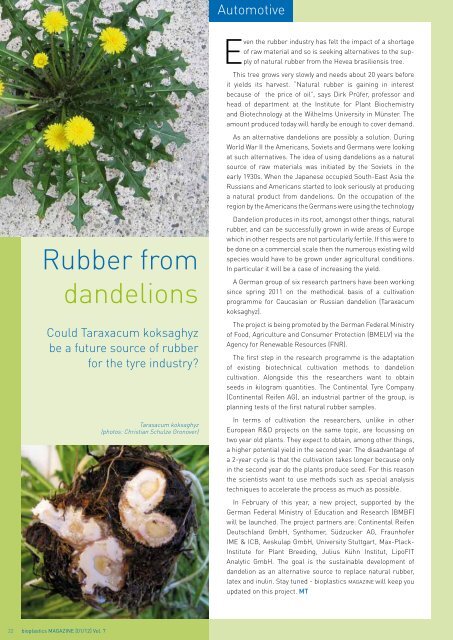bioplasticsMAGAZINE_1201
bioplasticsMAGAZINE_1201
bioplasticsMAGAZINE_1201
You also want an ePaper? Increase the reach of your titles
YUMPU automatically turns print PDFs into web optimized ePapers that Google loves.
Automotive<br />
Even the rubber industry has felt the impact of a shortage<br />
of raw material and so is seeking alternatives to the supply<br />
of natural rubber from the Hevea brasiliensis tree.<br />
This tree grows very slowly and needs about 20 years before<br />
it yields its harvest. “Natural rubber is gaining in interest<br />
because of the price of oil”, says Dirk Prüfer, professor and<br />
head of department at the Institute for Plant Biochemistry<br />
and Biotechnology at the Wilhelms University in Münster. The<br />
amount produced today will hardly be enough to cover demand.<br />
As an alternative dandelions are possibly a solution. During<br />
World War II the Americans, Soviets and Germans were looking<br />
at such alternatives. The idea of using dandelions as a natural<br />
source of raw materials was initiated by the Soviets in the<br />
early 1930s. When the Japanese occupied South-East Asia the<br />
Russians and Americans started to look seriously at producing<br />
a natural product from dandelions. On the occupation of the<br />
region by the Americans the Germans were using the technology<br />
Rubber from<br />
dandelions<br />
Could Taraxacum koksaghyz<br />
be a future source of rubber<br />
for the tyre industry?<br />
Taraxacum koksaghyz<br />
(photos: Christian Schulze Gronover)<br />
Dandelion produces in its root, amongst other things, natural<br />
rubber, and can be successfully grown in wide areas of Europe<br />
which in other respects are not particularly fertile. If this were to<br />
be done on a commercial scale then the numerous existing wild<br />
species would have to be grown under agricultural conditions.<br />
In particular it will be a case of increasing the yield.<br />
A German group of six research partners have been working<br />
since spring 2011 on the methodical basis of a cultivation<br />
programme for Caucasian or Russian dandelion (Taraxacum<br />
koksaghyz).<br />
The project is being promoted by the German Federal Ministry<br />
of Food, Agriculture and Consumer Protection (BMELV) via the<br />
Agency for Renewable Resources (FNR).<br />
The first step in the research programme is the adaptation<br />
of existing biotechnical cultivation methods to dandelion<br />
cultivation. Alongside this the researchers want to obtain<br />
seeds in kilogram quantities. The Continental Tyre Company<br />
(Continental Reifen AG), an industrial partner of the group, is<br />
planning tests of the first natural rubber samples.<br />
In terms of cultivation the researchers, unlike in other<br />
European R&D projects on the same topic, are focussing on<br />
two year old plants. They expect to obtain, among other things,<br />
a higher potential yield in the second year. The disadvantage of<br />
a 2-year cycle is that the cultivation takes longer because only<br />
in the second year do the plants produce seed. For this reason<br />
the scientists want to use methods such as special analysis<br />
techniques to accelerate the process as much as possible.<br />
In February of this year, a new project, supported by the<br />
German Federal Ministry of Education and Research (BMBF)<br />
will be launched. The project partners are: Continental Reifen<br />
Deutschland GmbH, Synthomer, Südzucker AG, Fraunhofer<br />
IME & ICB, Aeskulap GmbH, University Stuttgart, Max-Plack-<br />
Institute for Plant Breeding, Julius Kühn Institut, LipoFIT<br />
Analytic GmbH. The goal is the sustainable development of<br />
dandelion as an alternative source to replace natural rubber,<br />
latex and inulin. Stay tuned - bioplastics MAGAZINE will keep you<br />
updated on this project. MT<br />
22 bioplastics MAGAZINE [01/12] Vol. 7


















